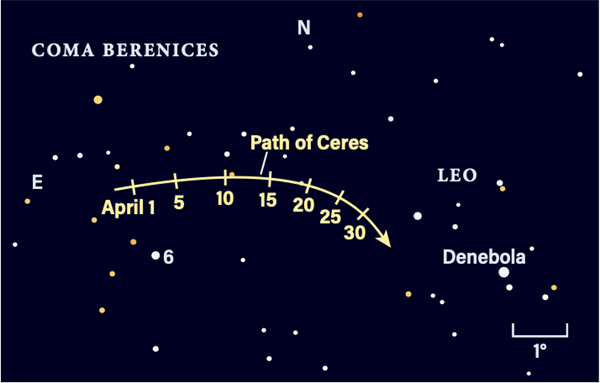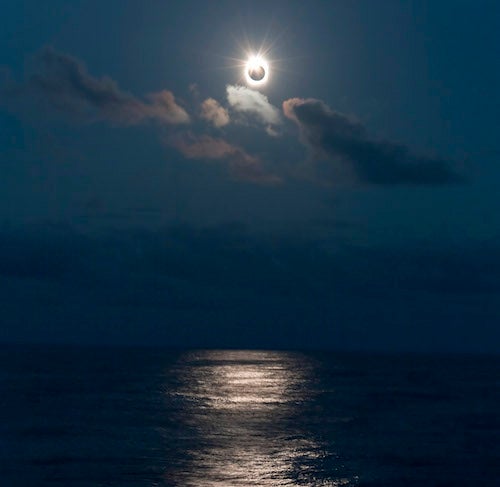
Mercury and Venus put on their best display of the year this month. Watch them each evening, with Mercury at its best in the first two weeks of April. Mars continues to recede from Earth and is a nice 1st-magnitude object crossing Gemini. Saturn reappears in the morning sky, with better views late in the month — why not plan to view the April Lyrids and the ringed planet together? Jupiter is too close to the Sun for observation this month, while Uranus and Neptune are challenging.
We begin our nightly tour of the planets with Mercury, which reaches its best evening appearance for the year during April and is visible almost all month. Look on April 1 for the innermost planet hanging 5° above the horizon 45 minutes after local sunset. Setting more than an hour after the Sun and shining at magnitude –1.1, it’s an easy twilight target. One or two stars in Aries the Ram may pop into view nearby if your sky is clear enough. Venus hangs 21° higher than Mercury and is easy to spot west of Taurus.
Mercury passes some 8° due south of Hamal, the brightest star in Aries, on the 6th, then climbs to its greatest eastern elongation 19° from the Sun on April 11. The planet dims to magnitude –0.1 during this period as its phase declines from 76 percent to 39 percent lit.
On April 21, a crescent Moon joins Mercury low in the western sky. Look first for the Moon soon after sunset. However, Mercury has faded to magnitude 1.9 and will be difficult to spot as it stands nearly 9° due east of the Moon, at lower altitude. The Moon is 12° high and Mercury is just 5° above the horizon. Note that magnitude 5.9 Uranus lies within 4° of Mercury, but it will be most challenging to spot unless you’re observing from high elevation with perfectly clear air. (Kitt Peak Observatory in Arizona is a good location.)
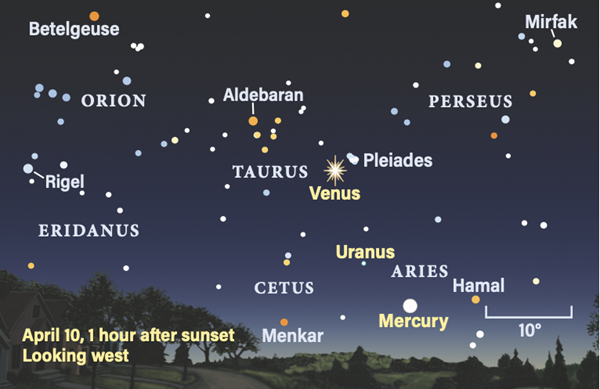
Venus dominates the evening sky, starting the month at magnitude –4. During April, it takes a visually dynamic path between the stunning Pleiades (M45) and Hyades star clusters, which themselves just beckon for attention. Catch the scene soon after sunset and get ready for some great views as twilight falls. Astrophotographers, now is your chance to capture scenic photographs by selecting artful and creative foreground objects that look great in silhouette against such a magnificent view.
Venus begins the month in Aries and stands 2.8° northeast of Uranus on April 1. By April 10, it’s 3° south of M45 and remains visible after 10 P.M. local time. A telescope reveals a 74-percent-lit disk spanning 15″.
Venus passes 8° due north of Aldebaran on April 20; the next night, a crescent Moon joins the scene just below the Pleiades. As darkness falls, the unlit portion of the Moon becomes visible due to earthshine. This phenomenon is a delicate and beautiful enhancement revealing the full disk of the Moon. An observer on the Moon looking back at Earth would see our planet almost fully lit, brighter than the Full Moon on a dark earthly night.
By April 22, the Moon and Venus are less than 7° apart in a glittering scene that includes the Hyades and Pleiades. Don’t miss this memorable view. A fatter, nearly four-day-old Moon is less than 6° above Venus on the 23rd. By now, Venus shows off a 69-percent-lit disk and has grown to a span of 16″. It has brightened to magnitude –4.1.
Through the end of April, Venus climbs through the fainter regions of Taurus and adds another arcsecond to its girth. It ends the month located almost midway between the two horns of the Bull, Zeta (ζ) and Beta (β) Tauri, reminiscent of the location of Mars back in November 2022. Between April 27 and 28, the inner planet reaches 1.0 astronomical unit (AU; 93 million miles) from Earth. In the following months, that distance will shrink and its disk will grow until Venus reaches inferior conjunction in August.

Mars makes a delightful appearance at the start of April, shining at magnitude 0.9 and standing 2° northeast of the fine open cluster M35 in Gemini the Twins. Grab a pair of binoculars to view this beautiful scene. A pair of 3rd-magnitude stars, Mu (μ) and Eta (η) Geminorum, sit about 3° south of Mars.
The Red Planet continues its sojourn across Gemini, passing very close to the double star Mebsuta (Epsilon [ε] Geminorum) on April 13 and 14 — on the latter date, it lies within a half-Moon’s width of the 3rd-magnitude star. Sometimes the Moon or a planet occults this star due to its proximity to the ecliptic. Mars occulted Mebsuta in one such rare event on April 8, 1976, when astronomers precisely measured properties of the planet’s atmosphere.
A waxing crescent Moon joins Mars April 25, when the pair are 3° apart. They hang under the watchful eyes of 1st-magnitude Castor and Pollux, which stand about 8° above Mars and the Moon. By the end of April, Mars is 2° north of Wasat (Delta [δ] Geminorum), another of Gemini’s double stars. Mars continues increasing its distance from Earth and, by month’s end, reaches 1.7 AU (160 million miles) away, resulting in a tiny disk spanning 5″. Telescopic observations of its surface features are subsequently very difficult. The planet remains visible above the horizon until well after midnight all month.
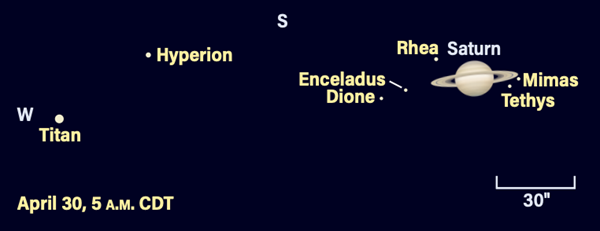
Saturn rises in Aquarius shortly after 5 A.M. local time on April 1, just as twilight begins. It’s a short observation window as the Saturn season opens, but by April 30, things have improved, with Saturn rising two hours earlier and reaching 8° high at the first onset of twilight. It glows at magnitude 0.9, outshining all the stars in this region of sky. A waning crescent Moon hangs 5° below the ringed planet on April 16.
Eager observers swinging a telescope to Saturn low in the sky will be pleasantly rewarded by its 16″-wide disk and a thin set of rings, now inclined by only 9° to our line of sight. They will narrow another couple of degrees as it heads toward an August opposition. In the meantime, enjoy the reappearance of the gas giant in our skies, along with its collection of moons. Titan will be easy to spot late this month, shining at 8th magnitude and due west of Saturn on April 30.
Neptune is just reappearing from behind the Sun in morning twilight. Its magnitude 7.8 disk is poorly placed for observation in Pisces, particularly early in the month. By April 30, it is just 7° high an hour before sunrise.
Jupiter is in conjunction with the Sun April 11 and not visible this month.
This month’s April 20 solar eclipse is an unusual “hybrid” eclipse. The eclipse begins and ends as an annular eclipse, but for most of its path, it is total. This occurs because the curvature of Earth causes the Moon’s shadow to fall short of reaching the surface for the east and west extremities of the track, where our planet’s surface curves away. But the eclipse is total along the central part of the track. Hybrid eclipses are rare, with just five to 24 per century.
April’s solar eclipse begins as an annular eclipse at sunrise over the waters of the south Indian Ocean and makes landfall on a tiny promontory of the Cape Range National Park, located 800 miles north of Perth, Australia. Totality lasts some 62 seconds at this remote location.
The moment of greatest eclipse, where totality lasts 1 minute 16 seconds, lies just off the coast of Timor. The track reaches tropical West Papua in the early afternoon, where mountains rise to nearly 10,000 feet and generate lots of weather. The eclipse track briefly visits the island of Biak (65 seconds of totality), which has some developing tourist centers and is the location of a major battle of World War II. The track then races across the Pacific Ocean, turning into an annular eclipse again near sunset, just south of the Marshall Islands.
The next solar eclipse is an annular eclipse on Oct. 14 across the western U.S. and northern South America. It will serve as a preview for the April 8, 2024, total solar eclipse that will cross parts of Mexico, the U.S., and Canada.
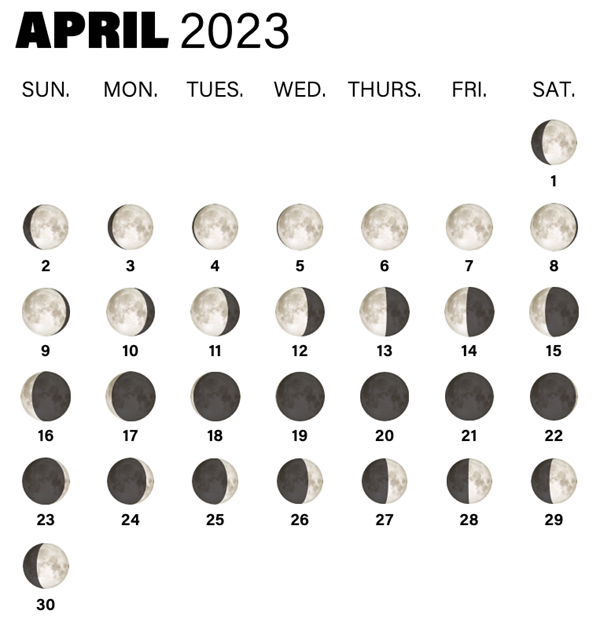
Rising Moon: The jagged shadow land
Towering turrets and chains of pointy peaks span the day-night divide of the First Quarter Moon on March 29. The parade of rugged crater walls continues night after night. In the north, the large, round, undulating Sea of Serenity suddenly gives way to a huge arc of mountains: the outer ring of the Mare Imbrium basin.
The massive impact threw out an incredible amount of material, much of which was subsequently buried when lava floods erupted through the cracked floors. You can see a load of excavated terrain chaotically dumped just on the southeast side of the grand Apennine chain.
Inside the arc lies the attractive oval form of Archimedes. Farther north, in the multi-ringed Mare Imbrium, look for the remains of an inner wall: It’s the large number of isolated yet grouped peaks sprouting out of this Sea of Rains. The long daggers of darkness knifing westward into the terminator shorten with each passing hour of observation and almost disappear in a couple of nights more.
Relive the shadows on April 27. Acting as a canvas, the smooth floor of Archimedes displays the remarkable saw-toothed shadows of the crater rim. But it’s all trickery due to the low-angle light from the Sun, which exaggerates apparent height. At the next sunrise or sunset around your home, try finding a smooth garden wall or guardrail: The low-angle light will cast a shadow that makes them appear covered with dangerous spikes.
Reversed light occurs on the 13th. If you’re up at 6 A.M., take in the black teeth biting eastward across the lunar soil.
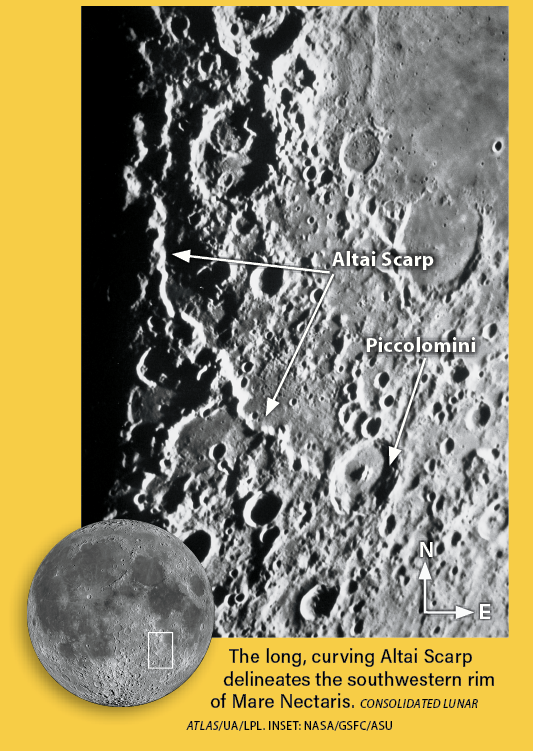
Meteor Watch: Look to the Lyre
The Lyrid meteor shower, active from April 14 to 30, peaks the evening of April 22 in the U.S. With the Moon out of the way as a slim evening crescent, conditions are ideal for observing this shower with dark skies. In the early morning hours, Lyra climbs to the zenith just before dawn. The radiant is already 35° high at local midnight. Rates will increase as the radiant rises higher in the sky.
The zenithal hourly rate is 18 meteors per hour and the expected observable rate should reach close to this number in the two hours before the onset of morning twilight. Meteors can occur anywhere in the sky, with longer trails most likely at least 30° to 45° away from the radiant in Lyra. Meteors tend to be brighter in the hour before dawn because the relative speeds of Earth and the shower particles are higher.
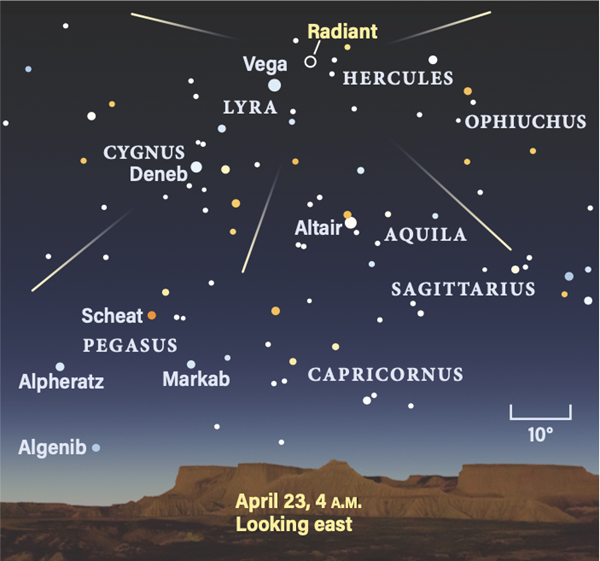
Comet Search: Get on the ball
As the winter Milky Way sets in the evening, so does Comet C/2020 V2 (ZTF), sinking through Triangulum in the northwest. The moonless window for viewing opens on the 8th; with ZTF only 10° high as astronomical darkness sets in, you need to be ready 90 minutes after sunset.
An anti-tail spike is possible from the 21st through the 26th. Imagers with a good stretch of weather can record the transition of the fan-shaped dust tail tilting edge-on, then leaning over to the other side as Earth punches through the comet’s orbital plane.
Visual folk need an 8-inch scope well away from city lights to deliver more than a mere glimpse of the small, 10th-magnitude fuzzball. Galaxy NGC 972 provides a comparative target.
ZTF’s closest approach to the Sun, perihelion, occurs May 8, but at 2.2 astronomical units, it lies beyond the orbit of Mars — too far for its diatomic carbon molecules to excitedly shine green. (One astronomical unit is the average Earth-Sun distance.)
If you’re up all night Messier marathoning through the Coma-Virgo Cluster, drop south of the ecliptic in Leo to hunt for C/2019 U5 (PanSTARRS), another faint Oort Cloud sibling masquerading as an isolated galaxy.
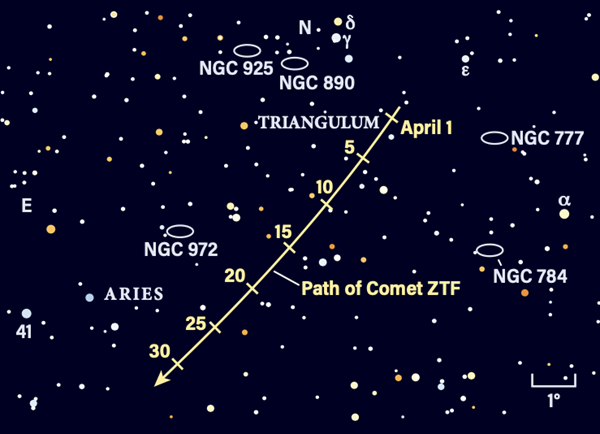
Locating Asteroids: Swing and spot
Time to bag an easy asteroid after a winter of stalking fainter ones. Dwarf planet 1 Ceres is a straightforward binocular catch from the suburbs, just 5° east (left) of Leo’s bright tail star, magnitude 2.1 Denebola.
Apart from three or four background stars, Ceres is the brightest dot in view. Use the chart to offset from Denebola and 6 Comae Berenices to orient yourself and peg the correct dot of light — William Herschel was right when he coined the term asteroid, Greek for “starlike.”
Even experienced observers make mistakes, so to be sure, plot a few stars on a sheet of paper or, better yet, a logbook, and return every few nights to confirm which point has shifted place. Ceres’ motion is a challenge to see in one observing session, even in a telescope. Use a triangle of field stars from the 10th to the 12th to reveal the displacement.
Spanning nearly 600 miles, Ceres is ruler of the main belt and massive enough to influence nearby orbits.
